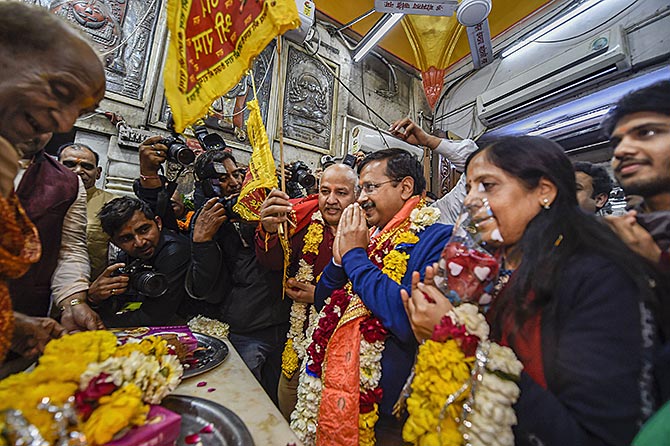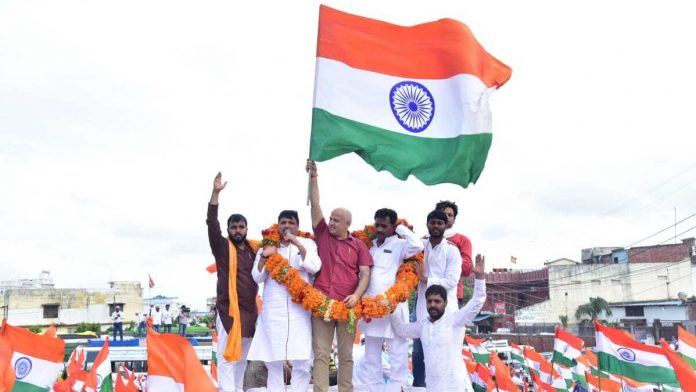
The Aam Aadmi Party (AAP) burst onto Delhi’s political scene in 2012-13 making the forgotten Aam Aadmi (common man) its ideological centerpiece. Led by a casually dressed and honest-to-a-fault leader, Arvind Kejriwal, AAP stood up for restoring the common man’s sense of pride and delivering him his rightful place as an equal in society. The series of corruption scandals under the UPA-II government gave the AAP just the right launch platform and they used it effectively to convince the people of Delhi of their brand of people-focused governance and representative politics. This sounded like a symphony to Delhi’s rickshaw wallahs, sabzi wallahs, and mazdoors who had found their champion. With the electoral backing of the common man, AAP went on to form the government along with the support of the Congress party in the 2013 Delhi Assembly elections.
Despite a series of missteps thereafter which led to re-election within 2 years, AAP’s electorate remained convinced of their messiah and AAP again formed the government on their own in 2015 with a 96% majority in the Delhi Assembly. Such was the strength of their ideology that they were elected for another 5-year term in 2020, with a thumping majority of 89% in the Assembly and near-complete sidelining of BJP, their main adversary. Only this time it was not the secular AAP of 2012-13 that got elected but a re-cast AAP with a significantly altered DNA.
A party that had until 2019 only education, development, and reform in their DNA, introduced “Hindutva” into their lexicon in 2019. This became their defining characteristic around which their political and personal ideologies were redefined and a new nationalism-infused narrative was created. This article is not about rationalizing AAP’s change in ideology but rather an attempt to understand the legitimacy of its intent. It is also about verifying if its original DNA that made them different from the other garden-variety political parties remains intact or has been lost forever in its quest for power.
The “right” turn to Hindutva politics and dominant nationalism
As a political ideology, the term Hindutva was articulated by Vinayak Damodar (Veer) Savarkar in 1923 and championed by the Hindu Nationalist organisation Rashtriya Swayamsevak Sangh (RSS), the Vishva Hindu Parishad (VHP), the Bharatiya Janata Party (BJP), and other organizations, collectively called the Sangh Parivar. The Hindutva movement has been described as a fascist variant of "right-wing extremism" which believes in a totalitarian concept of Hindu majority society.
By 2019, the Aam Aadmi Party with a diversified voter base that included minorities like Muslims and Christians had begun swerving right. The Supreme Court's 2019 verdict paved the way for the construction of the Ram temple at the disputed site in Ayodhya and with it created a new political discourse in India. Much before AAP’s embrace of Lord Ram, the party had already started its flirtation with Hindutva politics and began unabashedly displaying its newfound hyper-nationalism at every given instance. Consider this:
- It set aside ₹4,155 crores (8% of Delhi’s total budget in 2018-19) for providing free pilgrimage tours for senior citizens. Launched as the “Mukhyamantri Tirth Yatra”, all senior citizens from the Hindu, Sikh, and Muslim faith could visit their holy places free of cost. The scheme was later enhanced to include Ayodhya in the list of eligible places. This “model” scheme of Delhi is now being used to bait voters in Uttar Pradesh and Goa where AAP is hoping to make an entry in the 2022 Assembly elections.

- Closer to the 2020 election dates, Arvind Kejriwal announced himself as a devout Bhakt of Lord Hanuman by visiting the Hanuman temple and publicly reciting the Hanuman Chalisa.
- To further the Hindutva propaganda, the AAP government introduced the “Deshbhakti Curriculum” in Mar 2021 for all government-funded schools in Delhi. It took out full-page advertisements in all leading newspapers of Delhi to announce the curriculum “embedded in constitutional values” and proudly proclaiming “Now every child will learn patriotism. Now every child will become a true patriot.” One was only left to wonder about what happened to the existing syllabus which taught students that constitution – not religion or blind patriotism – is the bedrock of our civic society and its value system.
- AAP’s Deshbhakti sing-song was not for academic students alone but extended to state matters too when it called its annual budget the Deshbhakti budget. To put its money where its mouth is, it decided to install 500 high-mast Tricolours (flags) across Delhi at a cost of 85 crore rupees (about $11.5 million).
- In August 2021, Arvind Kejriwal promised to turn Uttarakhand into the ‘spiritual capital of Hindus’. AAP’s Chief Ministerial face for the 2022 Assembly elections in Uttarakhand, retired colonel Ajay Kothiyal, was showcased as “Bhole Ka Fauji” (warrior of Lord Shiva) and “Deshbhakt Fauji” (patriotic warrior) who alone could “bring a change in Uttarakhand”.

- AAP’s formal initiation of its election campaign for the 2022 Uttar Pradesh Assembly elections began with the Tiranga Yatra (the tri-color march) in Ayodhya with stop-overs at the Ram Janmabhoomi temple and Hanumangarhi The overt objective of the Tiranga Yatra was to celebrate the 75th year of India’s Independence while the not-so-covert objective was to convince its voters of its Hindutva credentials. This was evident when Manish Sisodia, a senior leader of AAP announced, "With the blessings of Shri Ramchandra Ji, we will raise the tricolor and teach real nationalism". The AAP aims to take out similar Tiranga Yatras in all 403 assembly constituencies of Uttar Pradesh in the run-up to the polls next year.
- In October 2021, Arvind Kejriwal and his cabinet colleagues celebrated Diwali with a grand puja at the city’s Thyagaraj Stadium in a pandal that was a “state of the art” replica of the Ram Temple being built in Ayodhya. This “unconstitutional” event was preceded by a huge publicity blitzkrieg which also had Kejriwal chanting ‘Jai Shri Ram’ on various FM channels and encouraging people to virtually participate in the event online.
What precipitated the change for AAP?
AAP’s swerve to the right needs to be understood in the light of many simultaneous changes that took place in India’s political landscape in the last 2-3 years and the existential challenges AAP foresaw in the years ahead.
Acceptance of the Hindutva narrative
The emergence of the staunch Hindutva narrative in national and state politics coincided with the rise of BJP winning the 2014 General Elections and 2017 Uttar Pradesh Assembly Elections. Between 2014 and 2018, most political parties tried their best to resist BJP’s aggressive Hindutva politics. But BJP’s even bigger victory in the 2019 General elections, despite its vitriolic anti-minority campaign, was seen as the nation’s endorsement of Hindutva and its potential to be a dominant force in Indian politics for a long time to come. It also convinced all political parties to introspect and realign themselves so as not to be seen as “anti-Hindu”. Everyone, from Rahul Gandhi to Akhilesh Yadav made sure their temple visits happened under full public glare as they didn’t want to be labeled as anti-Hindu. Such was the impact of the new narrative that even staunch BJP critic Mamata Banerjee was seen reciting the Chandi Path ahead of the 2021 West Bengal Assembly Election.
AAP was no exception to this understanding. By publicly adopting Deshbhakti, Ram, Hanuman, Ayodhya, it neutralized any detractors who could label AAP as “anti-Hindu” and thus a “traitor”, as per the new political grammar set by the BJP.
Regional Elections
With Delhi firmly under its belt and 5 states going into elections in 2022, AAP sees this to be a logical next step in expanding its footprint outside Delhi. It is statistically obvious that for winning elections outside Delhi, it must go beyond the secular bloc and woo the Hindu voter base currently siding the BJP.
AAP also knows that Uttar Pradesh, one of the most politically significant states is the fort that must first be conquered for it to be taken as a serious regional Opposition party. BJP, with Yogi Adityanath as its Chief Minister in UP, has a ready template for maneuvering the caste politics of UP. With firmly establishing its Hindi-Hindu-Hindutva ideology and with its success in the Ram temple in Ayodhya, has almost assured itself of a significant number of Hindu votes, never mind its handling of the Covid-19 pandemic. This is forcing AAP’s hand to showcase its Hindutva credentials to UP’s Hindu-majority electorate by embracing a hardline Hindutva stance.
As they say, if the ball does not stick to the wall, it will at least leave a mark. Even if AAP does not make any significant political breakthrough in the 2022 UP Assembly elections, it would have succeeded in convincing Hindus in Uttarakhand, Goa, and Punjab, which are also headed for elections in 2022 that the right-of-center space is no longer solely BJP’s bastion.
2024 (or 2029) General Elections
As presumptuous as it may sound today, there are nevertheless silent whispers in political circles about “After Modi, who?”. Each national and regional political party worth its salt is coalescing like-minded parties to become a national leader. Mamata Banerjee, especially after the stupendous election victory in 2021 and Akhilesh Yadav from UP harbor Prime Ministerial ambitions. Alongside, the Congress Party continues its state of lethargy and inaction.
The AAP finds a sweet spot for itself in national politics if it plays its cards right. And this need not be the 2024 General Elections, it may even be the 2029 elections for which it is taking baby steps to increase its voter base and regional presence.
So, who is the ‘real’ AAP?
| AAP’s public defense for its hyper-nationalistic brand of politics is its new-found inspiration for clean governance and administration through establishing Ram Rajya. When questioned on AAP’s sudden adoption of BJP’s brand of Hindutva, Arvind Kejriwal admits, “There is no right time to begin good work”. AAP is intent on convincing the electorate that its version of Ram Rajya and nationalism – of communal harmony and inclusive development, is the real one and that the RSS-BJP’s interpretation is fake, hateful, and divisive. AAP’s ideological hypocrisy stood fully exposed as it embraced the Ram temple in Ayodhya with as much zeal as it opposed its construction when it said earlier that “Ram can’t reside in a temple built on the debris of a mosque. |
|
In the process, they have muddied the waters as most voters today are “confused” on what exactly does AAP stand for. Their actions make it obvious that it is all about winning elections and being in power. Their speech make it seem all about politics of development and honest governance. In the process, they have lost their moral high ground to claim themselves as different from the rest of the political parties when in fact they have ended up like many others, copying BJP’s agenda of hyper-nationalism and excessive focus on religious identity. By abruptly withdrawing its campaign against the land purchase scam in Ayodhya, it only showed that it is dancing to the tunes of the BJP. No wonder then that its political rivals question AAP’s “lack of ideological consistency” and regard them as BJP’s B-team.
And this works out perfectly well for the BJP and RSS as they are the original creators of Hindutva model of politics and governance, and any other copy-cat parties will not enjoy any greater political mileage. There seems little likelihood of AAP beating the RSS-BJP in its own game with Hindutva upmanship. In fact, they only now have one more party sharing and tacitly promoting their ideological stand making it a win-win proposition for them.
While politics continues to be played out, the loser as always, is India itself. The secular fabric of the country continues to be torn apart with an even greater communal divide. The devastating scars of such polarisation during Partition should serve as a reminder to those attempting to emotionally manipulate us for political gains. Aam Aadmi Party, when it began was not just a conventional political party but an ideology representing secular and people-focused governance. By changing their DNA to fight the forces of hyper-nationalism and fascism, they have ended up becoming one of them instead.
Whoever fights monsters should see to it that in the process he does not become a monster. And if you gaze long enough into an abyss, the abyss will gaze back into you. - Friedrich Nietzsche
TO READ THE FULL ARTICLE

Get full access to the exciting content on The Mirrority by logging in
Support independent journalism
Even the very best of media houses in our country today are yielding to the pressure of click-bait journalism in order to survive. More than ever before, our country needs journalism that is independent, fair and non-pliant to the bureaucracy. Such journalism needs the support of like-minded readers like you to help us survive editorially and financially.
Whether you live in India or India lives inside you, help us continue to produce quality journalism with your contribution.
CONTRIBUTE
